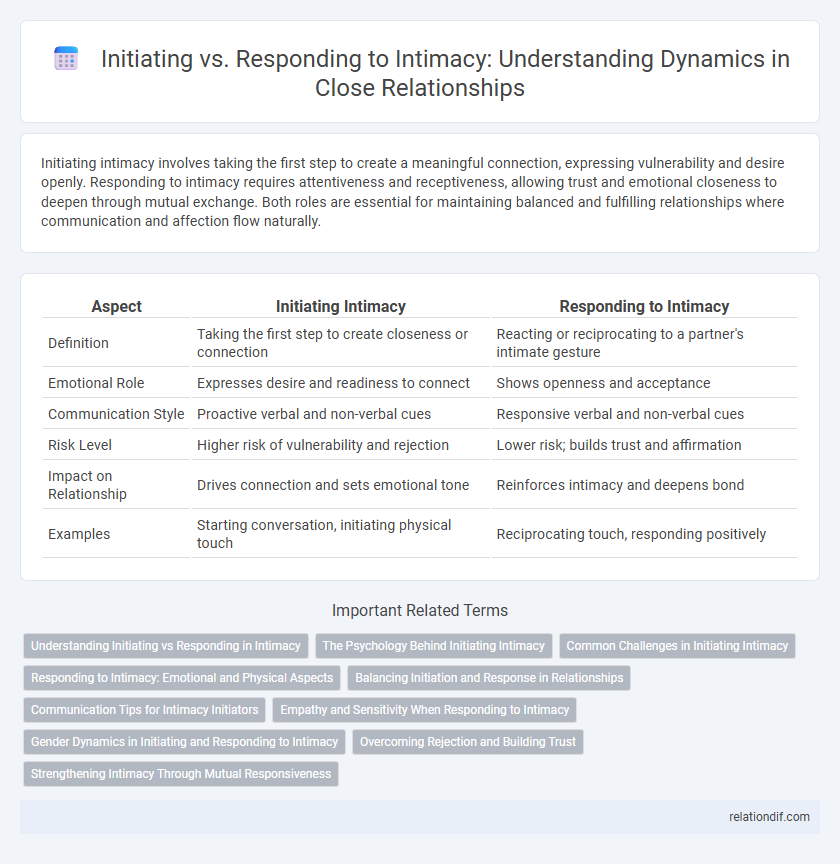Initiating intimacy involves taking the first step to create a meaningful connection, expressing vulnerability and desire openly. Responding to intimacy requires attentiveness and receptiveness, allowing trust and emotional closeness to deepen through mutual exchange. Both roles are essential for maintaining balanced and fulfilling relationships where communication and affection flow naturally.
Table of Comparison
| Aspect | Initiating Intimacy | Responding to Intimacy |
|---|---|---|
| Definition | Taking the first step to create closeness or connection | Reacting or reciprocating to a partner's intimate gesture |
| Emotional Role | Expresses desire and readiness to connect | Shows openness and acceptance |
| Communication Style | Proactive verbal and non-verbal cues | Responsive verbal and non-verbal cues |
| Risk Level | Higher risk of vulnerability and rejection | Lower risk; builds trust and affirmation |
| Impact on Relationship | Drives connection and sets emotional tone | Reinforces intimacy and deepens bond |
| Examples | Starting conversation, initiating physical touch | Reciprocating touch, responding positively |
Understanding Initiating vs Responding in Intimacy
Initiating intimacy involves consciously expressing affection, vulnerability, or desire to create a connection, setting the tone for emotional closeness and trust. Responding to intimacy requires attentiveness and receptiveness, validating the initiator's feelings and reinforcing relational bonds. Understanding the dynamics between initiating and responding enhances communication, promotes mutual satisfaction, and fosters deeper emotional engagement.
The Psychology Behind Initiating Intimacy
Initiating intimacy often involves a higher degree of vulnerability and emotional risk compared to responding to it, as it requires expressing desire and trust before receiving validation. Psychological factors such as attachment style, self-esteem, and past relationship experiences significantly influence an individual's comfort and motivation to initiate intimacy. Understanding these underlying mental processes helps explain the diverse ways people approach initiating intimate connections in romantic or close relationships.
Common Challenges in Initiating Intimacy
Common challenges in initiating intimacy include fear of rejection, feeling vulnerable, and uncertainty about the partner's readiness or interest. These obstacles often lead to hesitation and miscommunication, which can hinder the development of emotional closeness. Understanding and addressing these concerns through open dialogue and emotional support can foster a safer environment for initiating intimate connections.
Responding to Intimacy: Emotional and Physical Aspects
Responding to intimacy requires attuning to both emotional cues and physical signals, fostering a deeper connection through active listening and empathetic engagement. Physical responsiveness involves recognizing and valuing touch, eye contact, and nonverbal communication that affirm mutual affection and safety. Emotional responsiveness strengthens trust, vulnerability, and shared understanding, which are essential for sustaining long-term intimacy.
Balancing Initiation and Response in Relationships
Balancing initiation and response in relationships is crucial for fostering mutual trust and emotional connection, where both partners actively express and reciprocate intimacy to maintain harmony. Consistent communication and sensitivity to each other's cues help prevent misunderstandings and ensure that needs for affection and closeness are met equitably. Cultivating this balance enhances relationship satisfaction and supports long-term emotional resilience.
Communication Tips for Intimacy Initiators
Effective communication is crucial for intimacy initiators to express desires clearly, using open-ended questions and affirming language to create a safe emotional environment. Nonverbal cues such as eye contact, gentle touch, and body language enhance understanding and build trust during intimate moments. Active listening and validating the partner's feelings foster mutual respect, encouraging a balanced and consensual exchange of intimacy.
Empathy and Sensitivity When Responding to Intimacy
Empathy and sensitivity are crucial when responding to intimacy, as they foster trust and emotional safety between partners. Recognizing and validating a partner's feelings encourages open communication and deepens the emotional connection. Attuned responses to intimacy signals enhance relationship satisfaction by showing genuine care and understanding.
Gender Dynamics in Initiating and Responding to Intimacy
Gender dynamics significantly influence initiating and responding to intimacy, with societal norms often positioning men as initiators and women as responders. Research shows that men are more likely to initiate physical intimacy, while women tend to prioritize emotional connection before engaging. Understanding these patterns can enhance communication and balance expectations within relationships.
Overcoming Rejection and Building Trust
Initiating intimacy requires vulnerability and clear communication to overcome the fear of rejection, fostering a safe environment where both partners feel valued. Responding to intimacy with empathy and reassurance helps build trust, reinforcing emotional safety and encouraging openness. Consistent positive interactions strengthen the bond, making both initiation and response more confident and authentic.
Strengthening Intimacy Through Mutual Responsiveness
Strengthening intimacy relies on the dynamic interplay between initiating and responding, where mutual responsiveness creates a foundation of trust and emotional safety. Effective initiation involves attuned expressions of affection or desire that resonate with the partner's cues, fostering a deeper connection. Responsive partners validate and reciprocate these signals, reinforcing bond strength and promoting ongoing emotional engagement.
Initiating intimacy vs responding to intimacy Infographic

 relationdif.com
relationdif.com